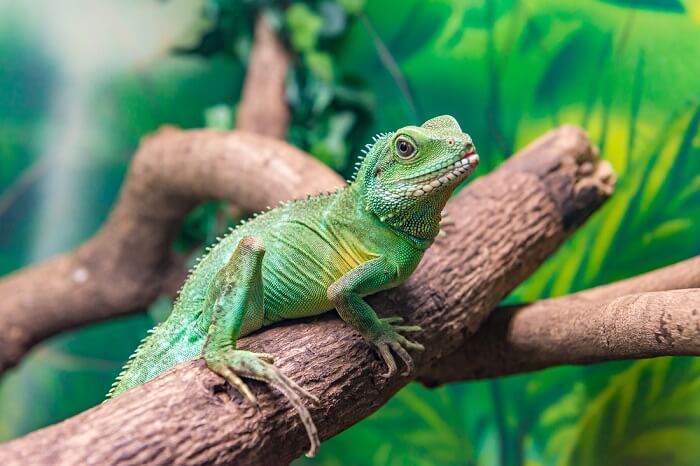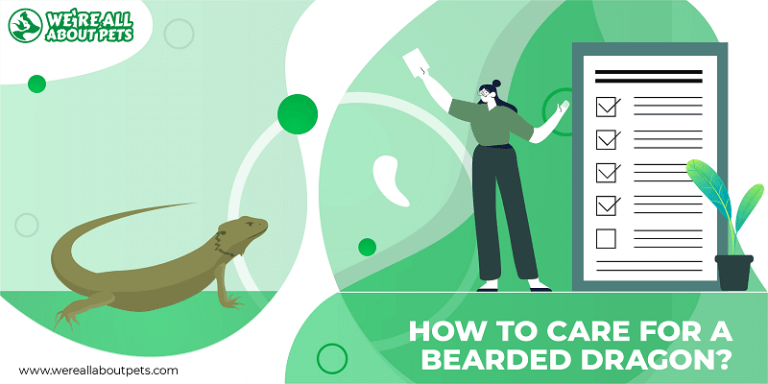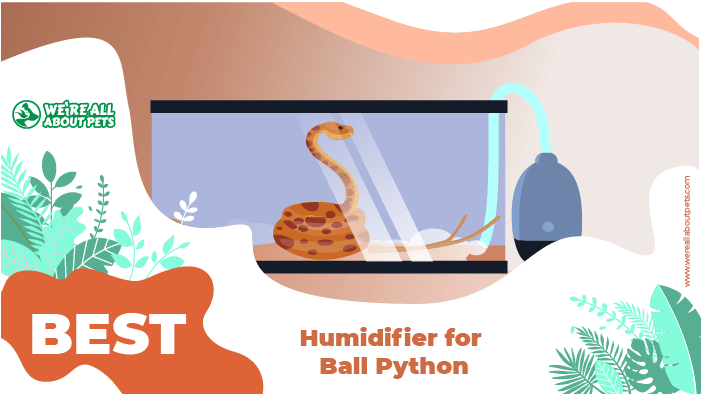What Do Tadpoles Eat? Get Your Pet’s Diet Correctly
This page contains affiliate links. We may earn money or products from the companies mentioned in this post through our independently chosen links, which earn us a commission. Learn More
If you have frogs as pets, you may end up with tadpoles to raise as well. Understanding their development and care needs will help you be able to care for them well and help them develop into healthy adults.
One extremely important recommendation is not to take tadpoles from the wild. They are part of a fragile ecosystem and removing them can be detrimental to their wild populations.
Releasing them back to the wild can be even worse, as this can spread disease to the wild populations. Of equal concern is that wild tadpoles could bring in diseases that could affect any amphibians you have at home.
Housing
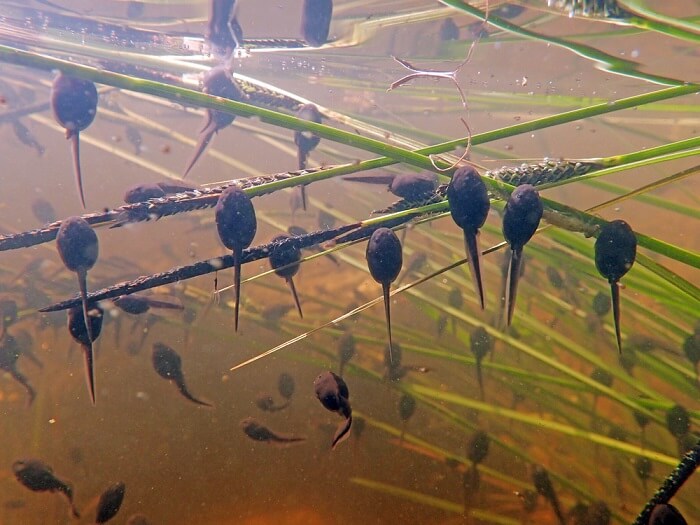
Briefly, before thinking about feeding you need to be sure the tadpoles are in a good environment. They should be removed from the frogs’ enclosure because frogs will compete for food at best, and may eat the tadpoles.
House the tadpoles in still freshwater. Ideally, there should be plants in the water. You can use a filtration system if it’s small enough to be safe for the tadpoles and the pump is slow enough that water movement is minimal. Alternatively, you can place artificial items for hides. You should also provide stable rocks or another item to allow them to get out of the water as they develop legs.
Prepare the water with a good quality water preparation solution to remove chlorine and chloramines. Monitor the water quality daily and maintain good water quality with cleaning and partial water changes as needed.
Diet
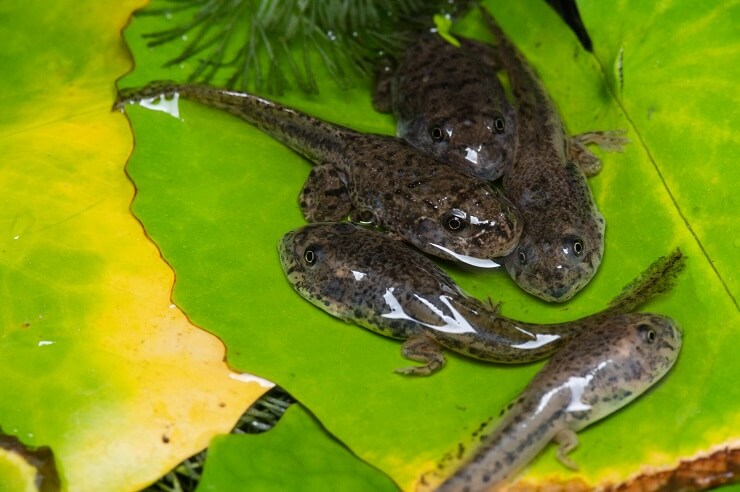
Keep in mind that tadpoles are rapidly growing young animals. They need to have a steady supply of food to support their growth. In just a few short weeks they’re transitioning from egg to frog. For a good, brief review of the life cycle.
They may not eat for the first few days. If they seem to be acting normally otherwise, it’s not a reason for concern. They usually hatch from the egg with some of the yolk sacs still attached, and that will give them nutrients for the first 2-3 days.
After using up the yolk sac, they’ll start on a vegetarian diet. In the wild, they’ll feed on algae and plants. If you have live plants in the aquarium, they may feed on those plants in addition to the food you offer.
Vegetables that are fed at this point should be boiled and cut into small pieces. Feed small amounts at a time, once daily. Whatever they don’t eat in 30 minutes should be removed to help prevent water quality problems, especially if you don’t have an active biofilter in the aquarium. Uneaten food quickly breaks down to ammonia, which is toxic to the tadpoles.
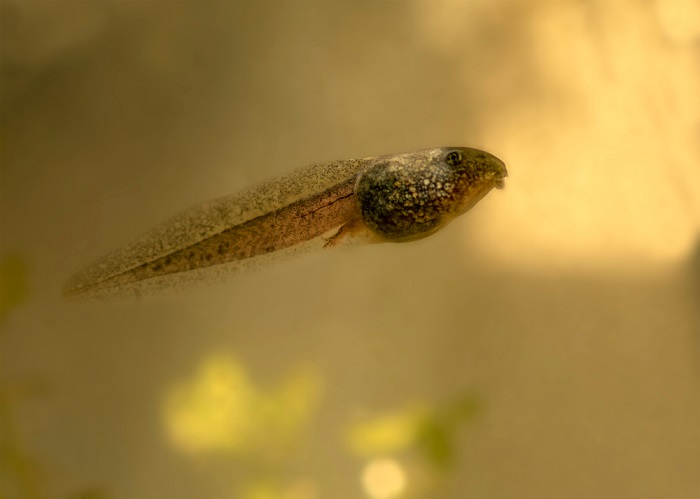
Some suggested vegetables:
- Cabbage
- Broccoli
- Red-leaf lettuce
- Green leaf lettuce
- Romaine lettuce
- Spinach
- Cucumber
- Zucchini
- kale
- Algae flakes or wafers
Offering a rotating variety is the best way to ensure that the nutritional needs are best met for the young tadpoles.
Somewhere between 2 and 4 weeks of age (depending on the species), they’ll start being better able to eat more solid foods. At that point, you can start to transition to an omnivorous diet by adding some animal protein.
As they grow, they’ll typically transition to more of an insect or meat-based diet. Insects should be pre-killed and fed in small bits when using the larger ones.
For the transition you can offer the following foods:
- Boiled egg
- Bloodworms (use a good vendor- ask at a high-end aquarium store)
- Mealworms
- Crickets
- Fruit flies
- Other larvae sole for reptiles
Vegetables can be continued to be offered as long as they show interest, even if they’re starting to eat insects. Fish flakes and frog & tadpole pellets can be used to supplement the feeding at this point of their development.
ZooMed and Omega One make good supplemental diets. With the insects and fish food, it’s also really important to remove uneaten items from the water after 30 minutes to avoid dangerous increases in ammonia.
Also be aware that the appetite may drop as the tail gets absorbed, and that can be normal as well. The developing tadpoles use the tail for nutrition as they resorb it.
What Not To Feed Tadpoles With?
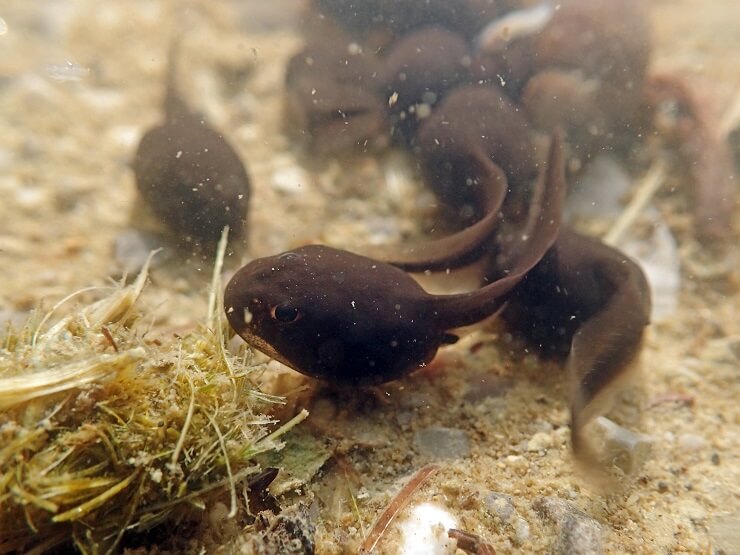
Just as important as what to feed can be what NOT to feed. Foods designed for other pets, like cats and dogs, won’t have the right nutritional balance. They’ll usually also contain elements that aren’t well digested by the tadpoles.
Fruits can be offered in small amounts, but are higher in sugar than what you want for the main part of the diet. Any processed foods could contain chemicals that may be toxic for the tadpoles and should be considered unsafe for them (and not so great for us sometimes!).
Muscle meat like beef, chicken or pork could contain harmful bacteria and lack the proper calcium for developing tadpoles.
Finally, bread lacks good nutrition and has a tendency to foul the water and fill the tadpoles with low-nutrition food that harms them by preventing them from eating good volumes of the food they need (true for ducks at the park as well!).
Summary
Feeding a good variety of vegetables and the proper transition to insect items can help the development of your tadpoles into healthy frogs.
There are some differences between different species, so additional information may be good for you to have. Contacting reputable frog breeders or zoos can be a good source of supplemental knowledge.
Frank Mutschmann, Dip. ECZM (Herpetology), Chitriomycosis in Amphibians, Journal ofExoticPetMedicine24(2015),pp276–282.
Norin Chai, DVM, MSc, PhD, DECZM (Zoo Health Management), Reproductive Medicine in Amphibians, Vet Clin Exot Anim 20 (2017) 307–325.

